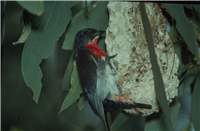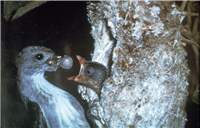Family
Dicaeidae
Genus
Dicaeum
Species
hirudinaceum
Threats/Control Methods - Regional
This species is dependant on Canberra's surrounding woodlands and the availability of mistletoe plants. These woodlands are considered an Endangered Ecological Community and are very sensitive to land clearing, grazing, weed infestations and droughts or bushfires.
Threats/Control Methods - Local
Reducing the areas of woodland reserves around the suburbs for urban development will impact this species.
Local/Urban Actions
Helping to maintain and improve the health of local habitats can be organised through a local Landcare group, or by joining a Greening Australia event.
Common Names
Mistletoebird, Mistletoe Flowerpecker, Australian Flowerpecker
Distinguishing Features
The head and back of this small bird of 10-11cm is very glossy black. It is most noticeable by its bright orange-red throat, breast and rump. Its underparts are white with a thick black stripe running from its breast to its rump. Females have a grey head, back, feathers and tail, with very pale, creamy-grey underparts and a pale red rump. Young birds are similar to females, with a yellow patch at the base of their bill.
Survey Techniques
Call and visual identification.
Species Call
Birdsong is loud and spirited, with sharp, high-pitched calls.
Similar Species
The Scarlet Honeyeater (Myzomela sanguinolenta) is similarly sized, but with a noticably long, downward curved bill. Male Scarlet Honeyeaters are different due to their entirely red head and back. Welcome Swallows (Hirundo neoxena ) have similar colourings, but have much longer tails.
Distribution
This species is found right across mainland Australia and in Papua New Guinea and eastern Indonesia.
Country of Origin
Australia
Conservation (Pet/Pest) Status - Regional
Numbers have fluctuated greatly since 1981, remaining fairly constant overall (COG).
Conservation (Pet/Pest) Status - National
Secure, not listed under the EPBC Act 1999.
LSCCES Population
Eight sightings were made at CSIRO during the survey.
Associated vegetation community
This species can be found in any forest where mistletoe grows, from coastal wet eucalypt forest, to woodland, to semi-arid areas.
Limiting Resources
This species is confined to areas with mistletoe. It has also been found sensitive to habitat simplification, requiring a mix of trees, shrubs and ground cover.
Breeding
Local Mistletoebirds breed in Canberra's surrounding forests from November to March. Their neat pear-shaped nest has a thin side slot and is suspended from an outer tree limb. It is built from soft vegetation bound with a spider web. Females build and incubate 3 white eggs before both parents feed the young for about 15days before the young fly from the nest.
Behaviour
Mistletoe birds sit alone or in pairs, flying and perching high through mistletoe-covered trees. Birds are usually only noticed by their call. When feeding on the mistletoe berries, the bird first removes the skin, and eats the jelly-like fruit. The bird gives a sideways bob to excrete the seed, wiping it on a nearby branch and starting the growth of a new mistletoe plant. This species migrates into the Canberra region for the summer, with numbers peaking in November. The bird moves further towards the coast for the winter months.
Functional Group
Food Species
This species eats only mistletoe berries and catches insects to feed to young.
Predators
Due to the high flying and perching behaviour of this species, they are less susceptible to attacks from predator species.
Interesting Fact
The smoothly rounded, wool-like appearance of the nest has led many to describe it as a baby's bootee.
References - (reader suitability of references, P=Primary teachers, S=Secondary students, T=Tertiary students and researchers)
Books:Freudenberger, D. 2001. Bush for the birds: Biodiversity enhancement guidelines for the Saltshaker Project, Boorowa, NSW. Consultancy report to Greening Australia ACT and SE NSW Inc. CSIRO Sustainable Ecosystems. Canberra. S, T
Morcombe, M. 2000. Field Guide to Australian Birds. Steve Parish Publishing. Archerfield. Australia P, S, T
Pizzey, G. 2000. The Graham Pizzey & Frank Knight Field Guide to the Birds of Australia. Angus & Robertson, Sydney. P, S, T
Veerman, P. 2003. Canberra Birds: A report on the first 21 years of the garden bird survey. Philip Veerman and Canberra Ornithologists Group. Canberra. S, T
Internet: Birds in Backyards. 2006. [online]. Available at:http://www.birdsinbackyards.net P, S, T
Canberra Ornithological Group (COG). 2004. Birds of Canberra Gardens. COG and the ACT Department of Urban Services. [online]. Available at:http://garden.canberrabirds.org.au/ P, S, T
Online Publications:ACT Government. 2004. Woodlands for Wildlife: ACT Lowland Woodland Conservation Strategy. Action Plan No. 27. Environment ACT, Canberra. [online]. Available at: http://www.environment.act.gov.au/nativeplantsandanimals/threatecspec/woodlandsstrategy S, T
Nix, H. and Cunningham, R. 2006. Birds of the Lower Sullivans Creek Catchment, Canberra ACT. Prepared for the Life in the Suburbs project using data from the Lower Sullivans Creek Catchment Ecological Survey (LSCCES). Australian National University. Canberra. [online]. Available at: http://www.lifeinthesuburbs.com.au/category.php?id=65 S, T


 Top
Top Top
Top